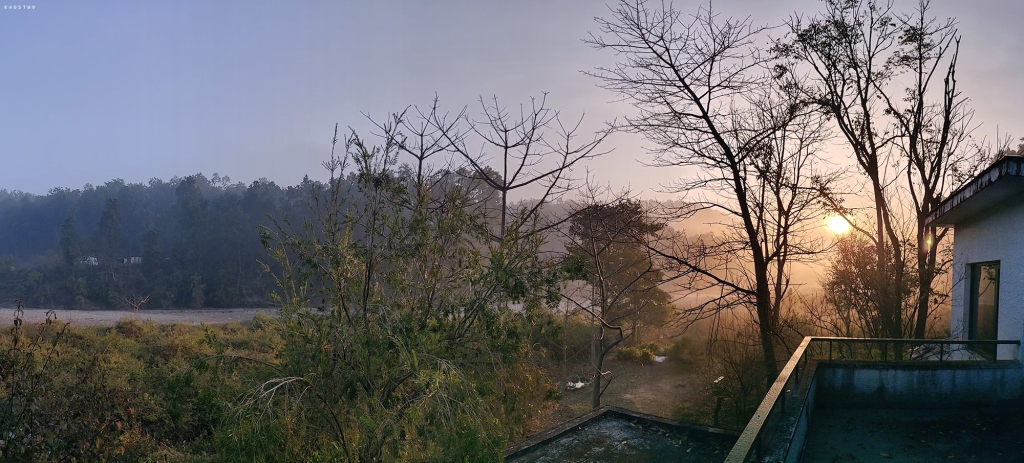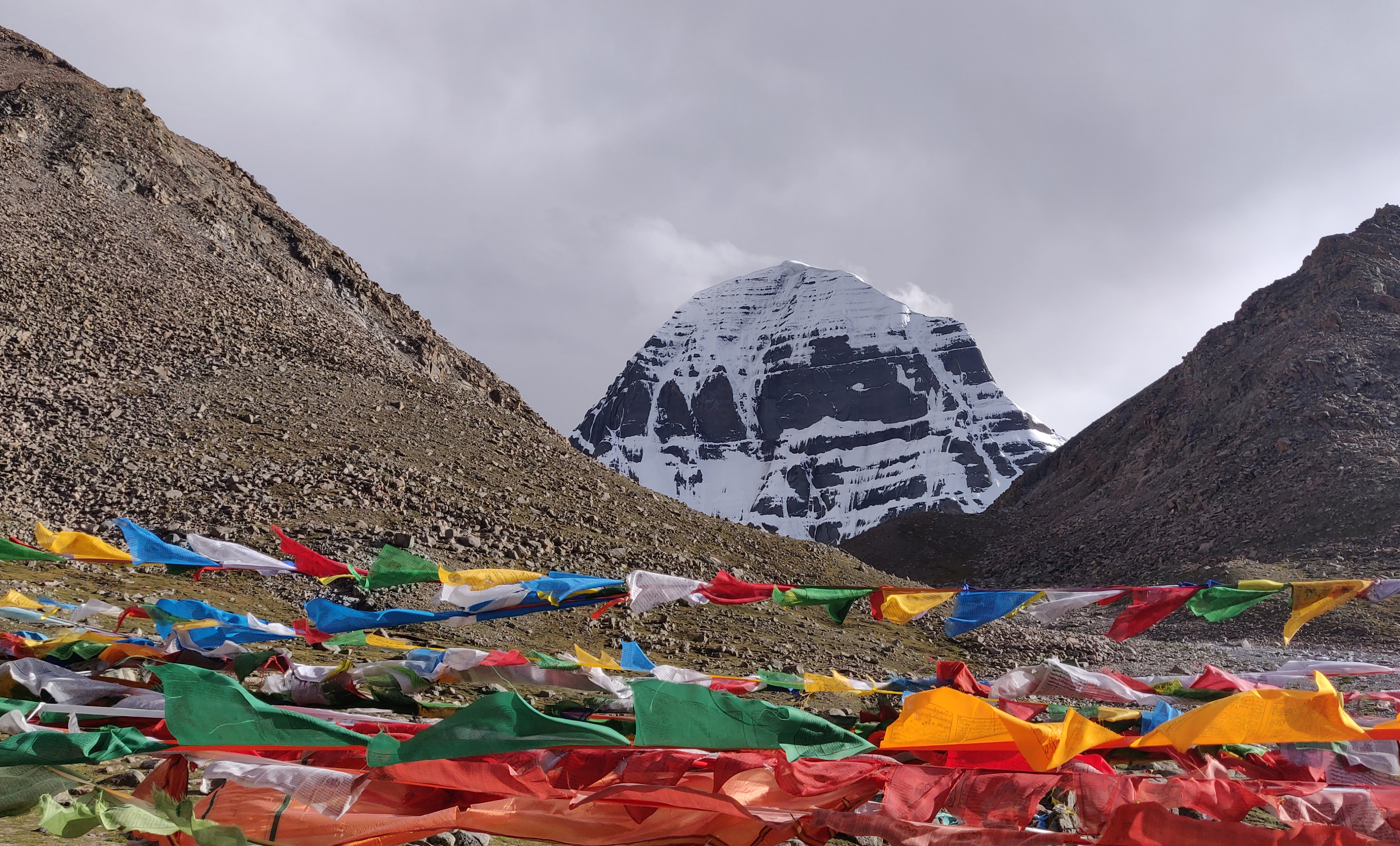Vignettes off the beaten track
Two hours from Lansdowne, a sleepy, picturesque hill station in Uttarakhand, is the northern division of the Corbett Tiger Reserve. Here lies the Sonanadi wildlife sanctuary, named after the Sonanadi river, an important tributary of the Ramganga river flowing through Corbett. The river got its name from decades of extensive gold panning in its alluvial beds, before the surrounding forests were made a protected sanctuary in 1987. Nearby is the Rajaji national park, another important tiger reserve in India. With jungle corridors connecting the two, these are some of most majestic, undisturbed forest tracts in Northern India, home to the second largest population of tigers in the world and one of the largest elephant populations in India.
Deep within the core zone of the Sonanadi tiger reserve lies the Halduparao forest rest house, built around 1890 or so by the British. Entry is through the ‘Vatanvasa’ gate, followed by a ten-kilometre drive through dense mountainous jungles, fording three river crossings. This picturesque forest rest house is perched on a high promontory on the banks of the Sonanadi river, also known as the Palain river in these parts. It commands a bird’s eye view of the river winding through the surrounding forests.
One cold February morning at 6:45 am, a Saturday, my friend Saurabh Upadhyay and I set out for this place from Gurgaon. As the kilometres rolled by, the vast urban sprawl of the national capital region gave way to flat, open farmlands with towers of high-tension transmission lines running through them. After a couple of hours, we turned left from the Meerut expressway into a narrow state highway. A thick mist hung over a long canal adjoining this road, reed beds and smaller farms shrouded in haze. With the city well behind us, we stopped at a nondescript ‘Jain Shikanji’ dhaba somewhere along this stretch and ordered parathas and chai for breakfast. While waiting I spied an interesting bundle of local beedis called ‘Sundari’. Whenever I travel out to jungles, I pick up the local smokes and soon enough the sweet, pungent aroma of a well-rolled beedi gave perfect company to the piping hot chai. Our aloo-pyaaz parathas finally arrived, hot and steaming, and we wolfed them down in minutes with considerable relish. Satiated, another round of chai to keep us warm and we were quickly on our way again.
We reached Kotdwar around 1 p.m and met Aman, our jeep driver and guide. I had got his reference from our regular jeep guy in Corbett, and he would be with us for the duration of our trip. After Kotdwar the road wound up through the mountains. In another couple of hours we left human habitation behind and entered the thick forests of the Kalagarh tiger reserve, a small adjoining part of the larger Sonanadi wildlife sanctuary. Saurabh slid open the sunroof and rolled down our windows, letting in the pure, cold mountain air laced with the smell of the jungle.

—
Waking early the next day, I freshened up before the others, then woke up Saurabh and the driver who was supposed to ferry us down. Found the latter snoring away oblivious to the world in a small shack. We had spent the night at a resort called La Hermitage, one of the many oddities that have sprung up to cash in on tourism. It was a ten-minute drive away from the Vatanvasa gate, located on top of a hill. We had to park Saurabh’s SUV somewhere well below the resort at a desolate turn in the hill with some trepidation, and continued up a steep, rough path that only their 4×4 pick up could negotiate. La Hermitage had good cottages, with some stunning views from the highest point in the property, but oddly put together amidst growing weeds. I remember staring at the full moon while waiting for the driver and his jeep. It hung luminously over the whole range of hills and forests visible from the hilltop. It was dark, and the world was yet to wake up.
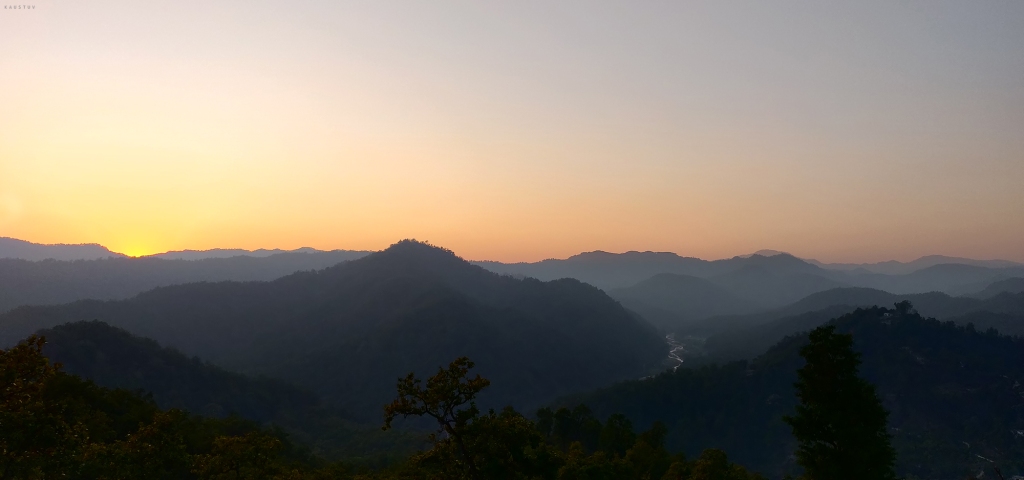
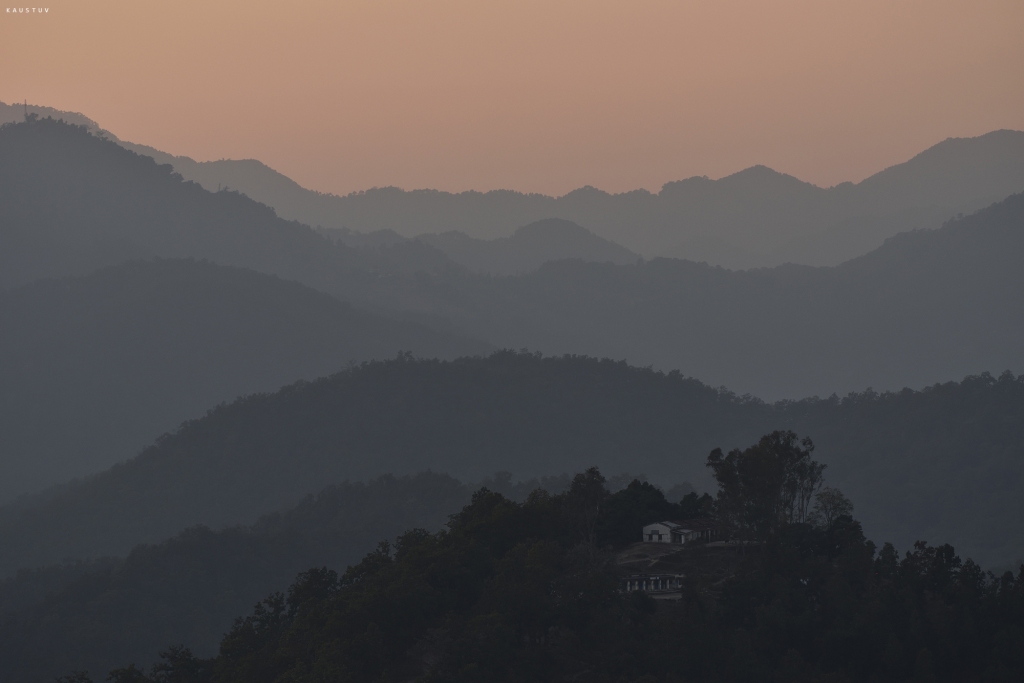
Coming down, we met Aman at Dhountiyal market, and took some time stocking up on vegetables and other provisions for our stay in Halduparao forest rest house over the next two nights. For the third night, we planned to stay in a place called Magpie cottage, on our way out from the forest, hardly a kilometre from this market. It would be a kind of soft landing before hitting back the grind of the city. A small, compact cottage by the side of the river, its approach was through a dirt path that led steeply down from the main road. Hemant, the caretaker was waiting for us and unlocked the main gate when we arrived. While Saurabh parked his car in a covered garage, a small exquisitely coloured bird emerged, and hopped onto the doorsill of Hemant’s humble outhouse. His wife was busy with morning chores, and his ten-year old son ran up to us and touched our feet with a heart-warming Namaste. The small bird hopped inside the doorway by the time Saurabh came out from the garage. I told him about it, but it was already 7 20 am, the sun was up, and we were getting late if we wanted to catch any morning action inside the forest. We left for the Vatanvasa gate.

—
Darkness shrouded the forest beyond the Vatanvansa gate. Aman made the entries and showed our booking ticket and identity cards to the forest guards. I caught up on a quick beedi, shivering in the early morning cold, thinking about our time to come in this unexplored forest, wondering what lay in store for us. In a short while the forest guards unlocked the gate, and as we drove in the temperature dropped down a few notches, and my fingers numbed in the intense cold. This part of the forest was in the sun’s shadow and a morning fog hung over everything. As we wound our way over rough and rocky tracks in these mountainous jungles, a flock of birds flew up from the valley where the river cuts through. I had never seen their kinds and strained for a glimpse through my binoculars. With what looked like green-gold panels on their wings and about the size of a medium sized thrush, they flitted through the mist uttering strange cries and disappeared deeper inside the forest.
The drive through this part of the jungle to the forest rest house was one of the most memorable in Corbett. We forded the Palain river time and again, its mirror-like surface rippling in the jeep’s wake, its reddish pebble-bed visible clearly in the early morning light. The powder blue skies, massed banks of trees gilt-edged by the rising sun and their perfect reflections in the serene river, offered an arresting vista as we drove deeper into this landscape.


—

We had the whole forest rest house to ourselves. It had two rooms and we had booked both. Located on the first floor, large and spacious, they looked out into a wide balcony with sweeping views of the jungles around. The original old forest rest house lay about fifty meters away, built by the British more than a hundred years ago. Its use was restricted to only forest officials nowadays, following some conflict with tourists the year before.

As we stood in the balcony looking at our surroundings, we noticed the richness of these primary forests right away. They seemed to be flourishing at every level, layer upon layer of different kinds of foliage, a profusion of species. Sal, Haldu, Baheda, Dhound, Kusum, Jamun, Gular, etc. were few among its many trees, along with numerous epiphytes, strangler vines, leafy under-stories and stretches of dense secondary growth.
There was this dark stretch, a very large grove of wild Jamun trees that Aman referred to as the Jamuni forest, immediately across the river from the forest rest house. Their interconnected canopy blocked out most of the sun, leaving light lancing here and there in sunbeams, transforming the interior into a dark green world of mystery.
After a short drive from this Jamuni forest through forests of Haldu & Sal trees, we drove out into a vast expanse of a valley. Grasslands, through which the backwaters of the Dhikala jheel wound its way, meeting the Palain river in a giant, serene sweep. Large black shoals of Mahaseer swam close to the water’s surface, at times leaping out to splash in back noisily. It looked as if they were feeding on some surface algae.


While wandering about on foot exploring the habitat here, I noticed a constant series of soft squeaky calls around me. Looking up there they were, what looked like a drift of Wire-tailed Swifts swooping about in their typical ariel acrobatics in the skies, feeding, snapping up insects on the wing. I trained my binoculars on them, only to find they weren’t Wire tailed swifts at all though they had the same trailing tail wires. I looked up my Inskipp and Grimmet guide on the phone, one that has recordings of bird calls in it. Coming up on the page that had all the Swift species, I started playing their calls one by one and the Crested Tree Swift’s matched what we were hearing. After managing a few clear shots of these fast-flying gliders with many a missed attempt, there was no more doubt left! These are striking birds, sporting prominent dark green-blue crests visible when perched.

This huge open vault deep inside the jungle’s core area was silent and still, seemingly more so with the soft calling of the Crested Tree Swifts. From time to time a few grass birds and ground feeders emerged from the understory of its grassland. One such was the exquisite and rare White Tailed Rubythroat, this one being the Himalayan Rubythroat variant. After it had disappeared back into a thicket, a Changeable Hawk Eagle juvenile started calling, insistent, repetitive, crying from a distant tree-top for its mother to return with food, somewhere in the far reaches of the jungle in the gathering dusk.
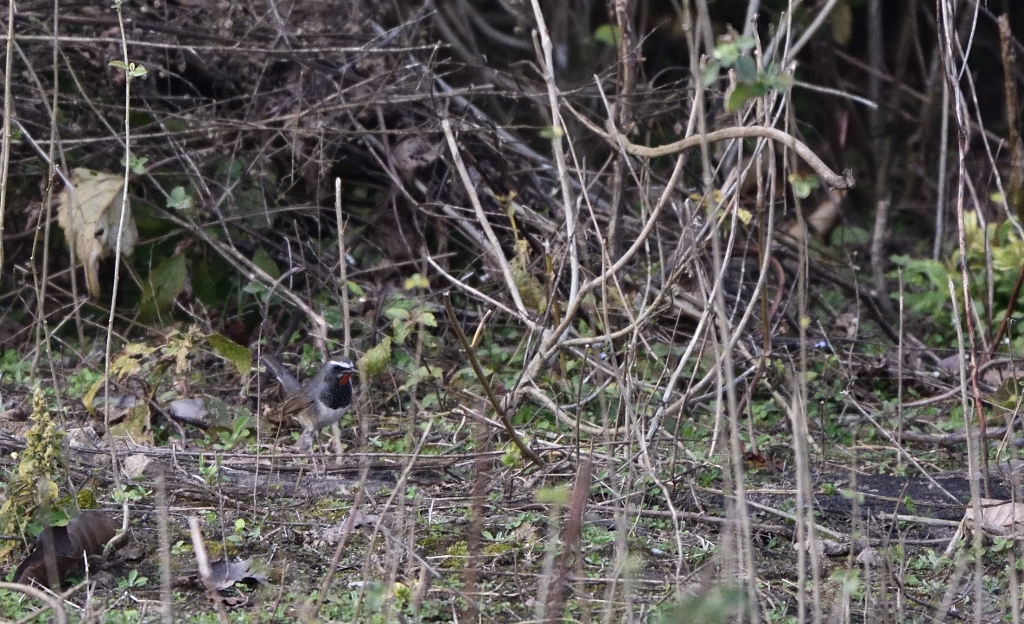
The jungle revealed itself to us bit by bit over time as we immersed ourselves in it. Just before the forest led out into this valley-vault, stood a mighty Sal tree and one of its upper branches hid a very large Pallas’s Fish Eagle’s nest. We discovered it while a family of three Giant Slaty Woodpeckers, the largest woodpeckers in India, played hide and seek with us on this tree trunk. They were considerably darker, almost black, than the grey ones I had seen in Dudhwa many years ago. We must have approached too close, for they flew away in alarm with loud cries. As we lowered our cameras and prepared to move on, I spied the profile of a large bird of prey swooping over the forest canopy in our direction. Timing my shot to get a clear image of it through a gap in the trees overhead, who should it be but the Pallas’s Fish Eagle, with a fish in its talons making for its nest!
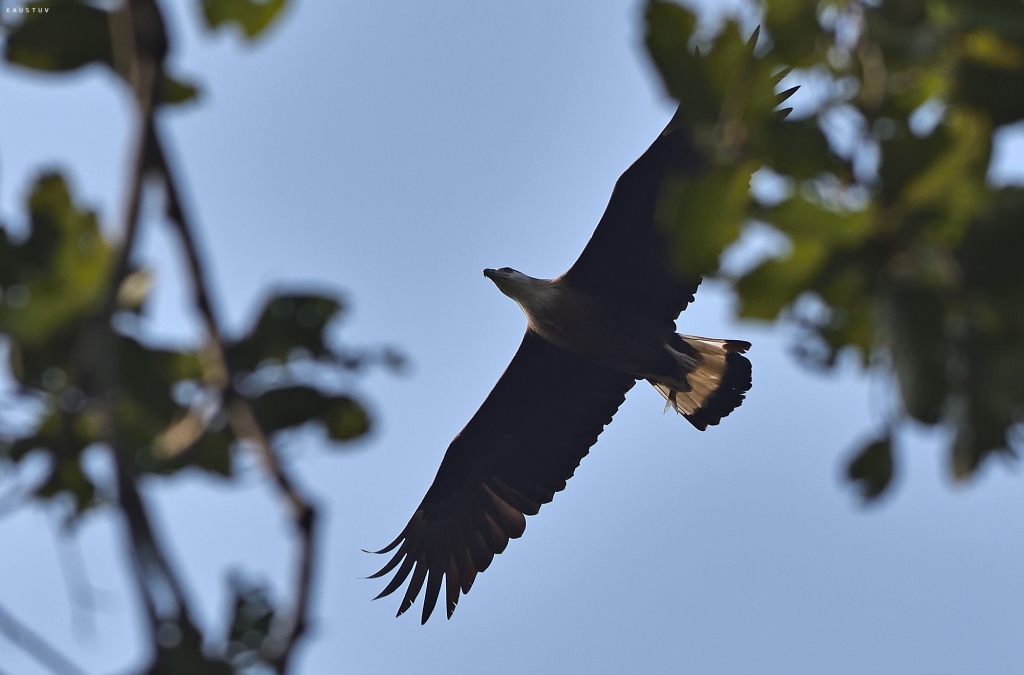
We also saw an elusive flock of rabble rousing skulkers, the White Crested Laughingthrushes, foraging on the ground in the understory of large lantana thickets hereabouts. Their loud and comical babble sounds like nothing on earth when you hear them up close. Most of the time that’s how you know they are around, traveling inside the forest understory foraging in large flocks, very sociable birds. Once in the Dhikala zone in Corbett, we were returning to the forest rest house when they started up their cacophony, and we literally jumped out of our skins at their raucous, super loud babble!
Grey Headed Fish Eagles perched patiently on the higher branches of trees by the river. Large, powerful birds of prey, their unearthly calls were almost banshee-like. Trying to get close to one, I had the pleasure of tiptoeing on foot over the pebbly, sandy riverside. All my senses were on a high alert, adrenalin pumping, quite aware I was in prime tiger territory. These powerful raptors are quite wary and do not allow a close approach. After watching me sharply for a while, it took off and flew into the Jamuni grove as I neared.


While it did, a Crested Kingfisher flew past and landed on a smooth boulder jutting out mid-stream in the river. I turned and started making my way to it very slowly, stopping every now and then to click a picture. It kept an eye on me turning its head this way and that, but let me approach. What a beautiful bird this is from up close, large with complex patterns of white and black streaking all through. Its image was made all the more special by the morning sun shimmering on the river. On foot, you are part of the jungle instantly.

The forests here abound in a rich diversity of bird life. At one Kusum tree, I counted ten species. They were foraging, part of a mixed wave hunting party, undeterred by Saurabh’s snoring. Through our days here, we saw six species of woodpeckers – the Brown Capped Pygmy Woodpecker, Fulvous Breasted, Streak Breasted, Lesser Goldenback, The shy Great Slaty and the Rufous Woodpecker. And yes, of course the numerous Nuthatches, Indian and Chestnut Bellied. They were there all over, almost in every tree crawling over like bugs, busy scouring every nook and cranny in the bark and hollows of the tree trunks, feeding on insects.


The Oriental Pied Hornbill made in an appearance three times, once with a pair gliding gracefully above us while our jeep was parked in the middle of the river. We were watching and photographing a Crested Kingfisher that was busy fishing on this stretch of the river right below the forest rest house. It caught three small ones, gulped two down quite neatly but lost the third with a beak flip gone wrong!


The diversity of trees, creepers and other flora is very different here from the Dhikala and Bijrani zones of Corbett National Park. The mountainous terrain’s higher altitude and relatively undisturbed nature of these forests have nurtured great diversity and growth. Ours was the only jeep around and this heightened our sense of complete immersion into this world.
—
Its melodious song flowed like a quick flowing stream, of limpid, dancing notes. I had just woken up and was getting ready in my room. Peeking through my window, who should I see but my old friend, the Blue Whistling Thrush, perched on the staircase handrail coming up to our rooms. It was pouring out its melodious song in the cold morning light. I had first heard it singing on a similar morning at Chalocha, a completely wild place deep inside the Great Himalayan National Park at an altitude of more than 9000 feet. I remember having crawled out of my tent in amazement, wondering who could it be? They are one of the most complex songsters in the forest, at times singing their elaborate symphonies for minutes on end.


Later when we started our safari, we found a large Brown Fish Owl dozing on one of the branches of a tree right outside the forest rest house. It had opened one eye, then another, and then proceeded to glare at us with both. Meanwhile, we twisted and turned in all manner of ways in the jeep’s seats, trying to capture a clear shot of it through the dense foliage. We found its partner a bit further ahead on another tree. Aman told us the area was home to a big male leopard that had been sighted several times in the past week.
Twice, towards evening, when we were in that vast open valley by the winding backwaters, we had heard the Owl boom, a single curious call that travelled a long distance. The forest seemed to deepen when it called, revealing its wild world, hinting at so much that goes on hidden from sight, where we don’t belong. Shortly thereafter a nightjar’s ‘chock-chock-chock’ started up telling us it was time to head back to the safety of the human outpost here, the Halduparao forest rest house.
—

On the last day’s morning safari I went out by myself along with Aman our driver, as Saurabh wanted to sleep some more and take it easy. Sunrays radiated through the upper canopy of the Jamuni forest and I spent time photographing their magic and the forest-scape. The Slatys called again frenetically and moved off deeper into the jungle hearing our jeep coming close. The open grassland lay serene and still, large herds of Chital foraged in the grasslands across the river, vast tracts of naturally growing wild marijuana. While returning, I had stopped on the track leading to the forest rest house. A fine specimen of a Crested Serpent Eagle was sunbathing with its wings open, on the bough of a large tree. That familiar, raucous babble sounded and a flock of White Crested Laughingthrushes emerged from the undergrowth down the track crossing over to the other side of the jungle. They were out for just a few seconds in the open, and one male paused to look me over curiously, before hurrying away with the rest.
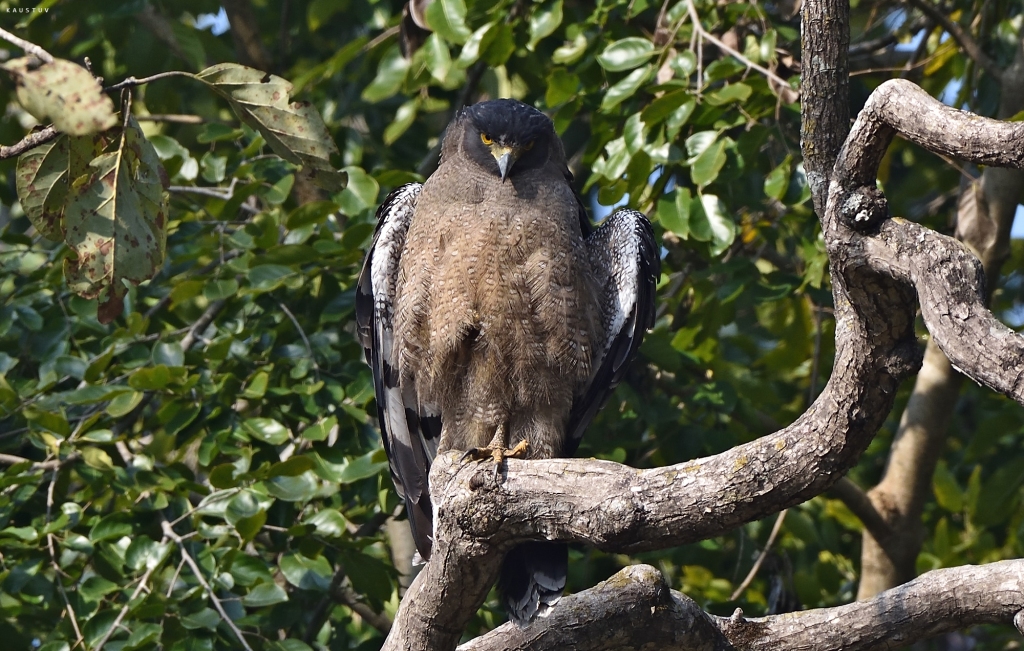

Three excellent paranthas and some great chai, after which we left Halduparao forest rest house. The sunlight was golden and crisp, simply one of the best days I have been in the jungle. Its beauty sparkled and shone, and we sat entranced in the jeep travelling up and down through these mountain forests, the morning winter sun burnishing each leaf, lighting up the different colours of the jungle in all their glorious splendor. A Rufous Woodpecker hopped up the trunk of a thick Haldu tree and disappeared into a hollow nest. A male Scarlet Minivet perched on a twig, its bright red plumage dazzling. A little before the Vatanvasa gate, we heard strange bird cries I thought I had heard somewhere before. A few of these birds finally emerged, one sitting on a branch quite close. It had the same green-gold paneled wing I had seen while entering the forest three days back. Identifying it with a clear picture I took – it turned out to be the Ashy Bulbul, a striking, beautiful lesser seen species. That was a nice loose end tied up from the sighting of three days ago!

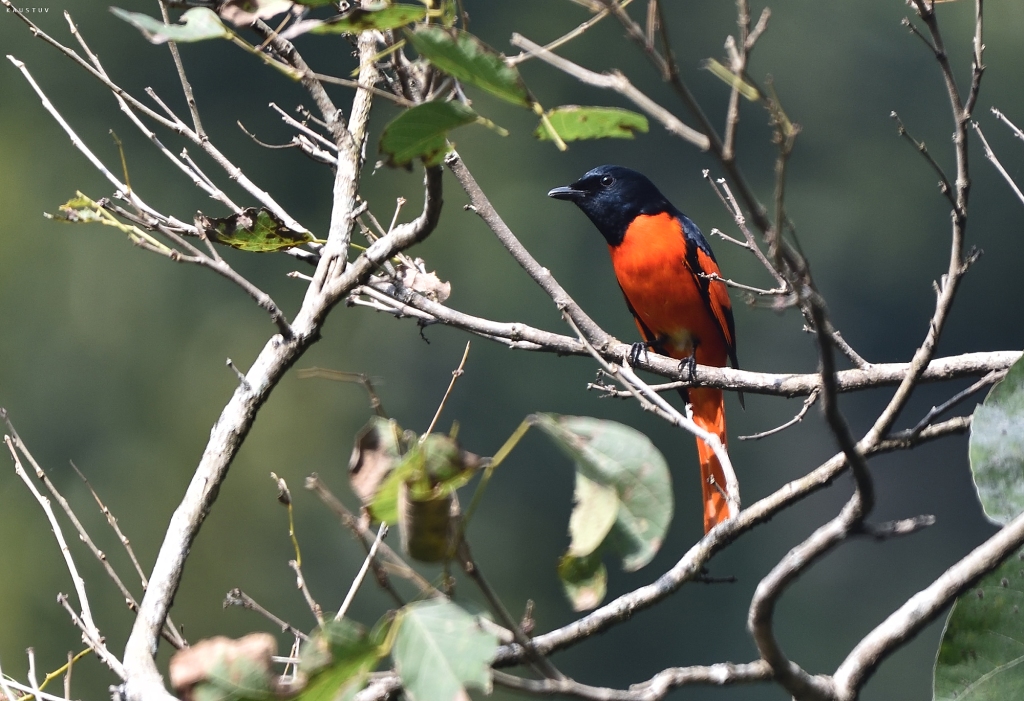
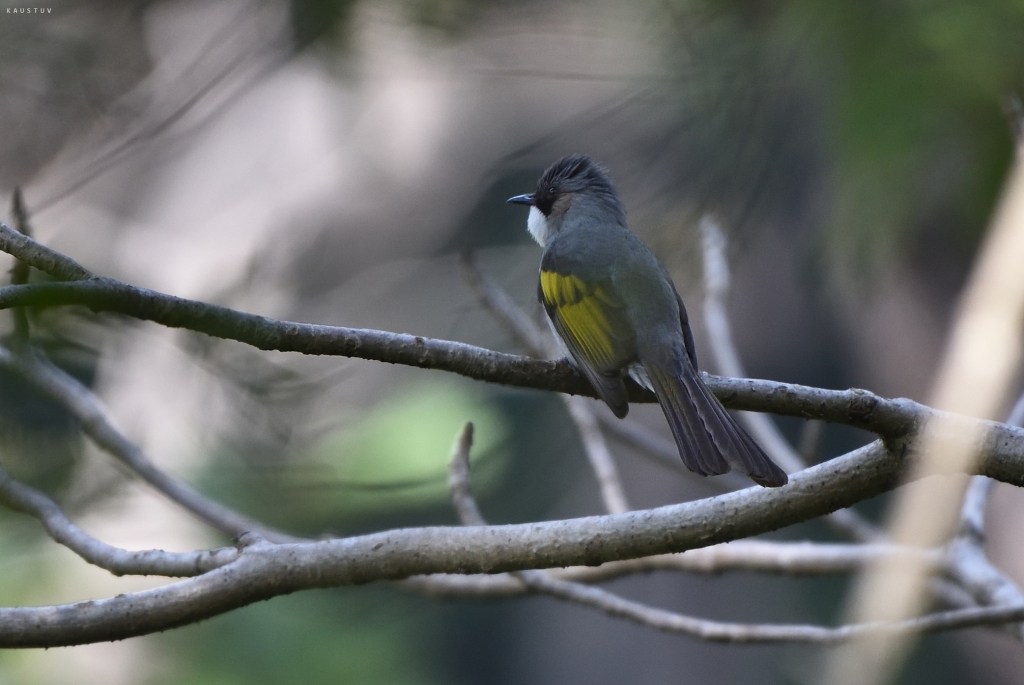
We stopped for a while outside the Vatanvasa gates and Saurabh and I went over the map of Corbett drawn over a large wall by the side of the forest checkpoint. We saw where we were, and the other forest rest houses dotted here and there on it, the ones we had stayed in many previous trips – Gairal, Dhikala, Bijrani, Malani, Sultan, Jhirna. And the ones yet unexplored, that caught our imagination – Lohachaur, Rathuadab, Kanda and a few others. Looking at the map fresh from our explorations from Halduparao, our minds were already turning over options for the next one. The mountainous Kanda maybe, the highest forest rest house in Corbett, haunt of black bears, leopards and rare Himalayan birds in the winter?

——-x——-
At Magpie Cottage, the final night. Hemant the caretaker, cook and man Friday recounts a story of a week ago. During an evening walk with some guests, they had come upon a sambar kill below a bridge about a kilometre away from the cottage, with a tiger cub over it. By and by as they waited, it fed and was soon joined by another larger sub adult cub. The tigress eventually emerged from the neighbouring thickets, and after a while a large male had stepped out in the fading light. They had quietly watched the family feed for a good half an hour, to the crunching and cracking of bones and the buzz of crickets in the gathering dusk.
Later that night, I had walked out on the terrace for a last smoke after drinks and dinner. It was well past midnight. Dark forests surrounded the cottage on all sides, the Palain river cut a silver ribbon through the forest, white stones gleaming along its banks. A mist hung all over, softening and blurring everything by the light of the full moon.
